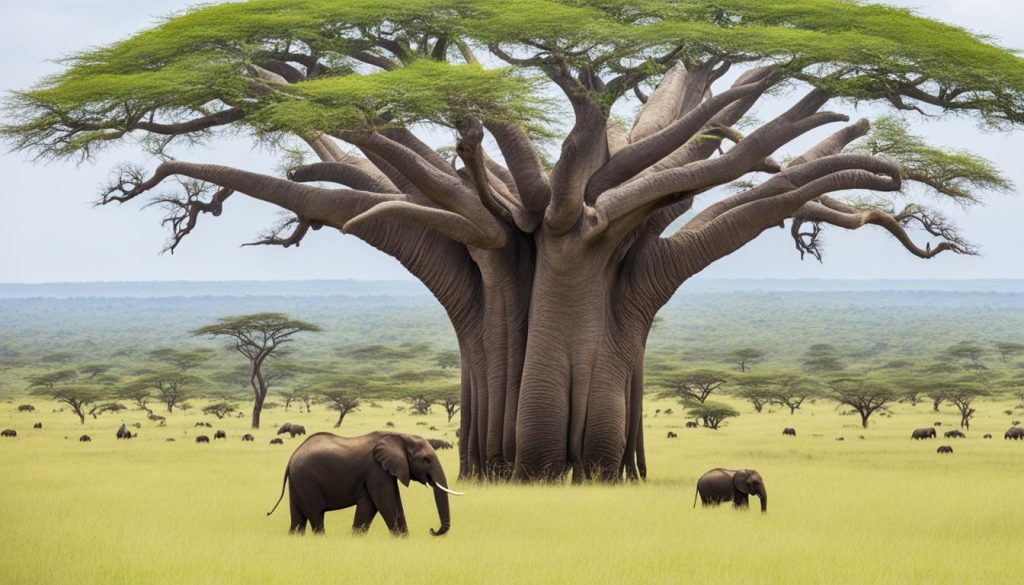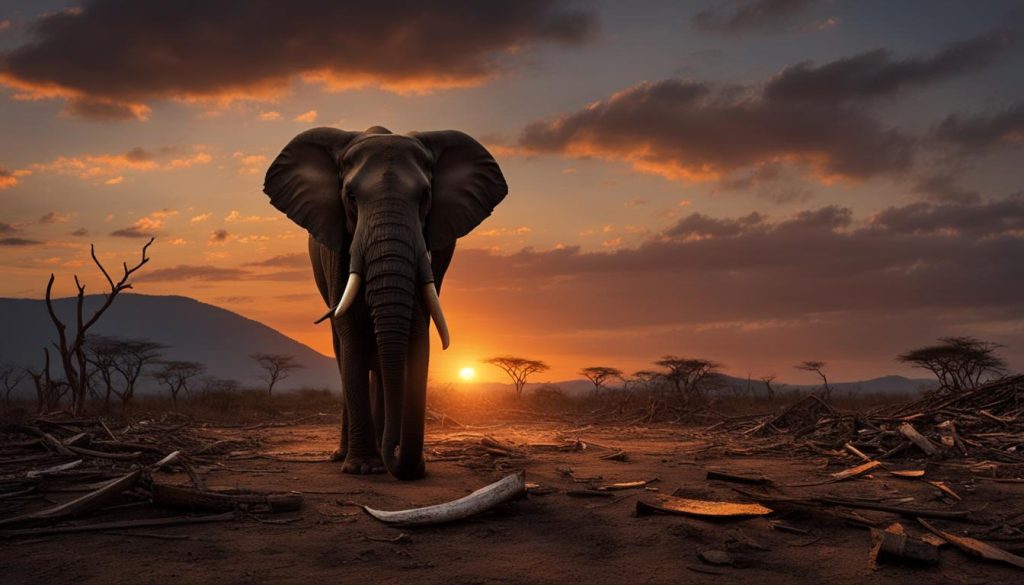Elephants, the jungle giants, are truly captivating creatures that mesmerize us with their size, grace, and intelligence. Whether you’re an experienced photographer or just starting out, capturing the majestic beauty of elephants in their natural habitat can be an exhilarating and rewarding experience. Join us on a journey as we explore the world of elephant photography, from the wanderings of China’s Asian elephants to the conservation efforts in Tsavo National Park.
Key Takeaways:
- Photographing elephants on safari requires unique perspectives to highlight their size and family dynamics.
- Capturing elephants in action showcases their power and distinctive body postures.
- The Great Elephant Census provides crucial insights into African elephants and their habitats.
- Tsavo National Park serves as a sanctuary for elephants, facing challenges such as human-elephant conflict.
- The devastating impact of the elephant ivory trade threatens the survival of elephant populations.
Tips for Photographing Elephants on Safari
When photographing elephants on safari, capturing their majestic presence and unique behaviors can result in stunning images that truly capture the essence of these magnificent creatures. Here are some tips to help you make the most out of your elephant photography expedition:
- Let their size stand out: Elephants are known for their impressive size and stature. To emphasize this, consider positioning yourself at a lower angle, such as lying on the ground or using a remote tripod, to create a more dramatic perspective.
- Focus on family dynamics: Elephants are incredibly social creatures, and their familial bonds are strong. By capturing moments of affection, tenderness, and playful interactions between family members, you can tell a heartwarming story through your photographs.
- Capture them in action: Witnessing elephants in motion is a breathtaking experience. Try to photograph them during moments of activity, such as walking, running, or even charging. These dynamic shots showcase their power and unique body postures.
- Highlight their playful nature: Elephants often engage in activities like dust spraying or playfully splashing water with their trunks. These playful moments not only demonstrate their intelligence but also create visually engaging images full of life and personality.
- Create abstract compositions: In addition to capturing the overall beauty of elephants, don’t be afraid to focus on specific features or details. Isolate their tusks, trunks, or even their wrinkled skin to create abstract and artistic compositions that provoke intrigue and evoke emotions.
Remember, the key to capturing stunning elephant photographs is to spend time with these incredible creatures, observe their behavior, and allow their story to unfold through your lens. Let your passion for wildlife photography shine and embrace the breathtaking moments that await you on your safari adventure.
Recommended Camera Settings for Elephant Photography
| Camera Setting | Recommended Value |
|---|---|
| Aperture | f/4 to f/8 |
| Shutter Speed | 1/500 to 1/1000 seconds |
| ISO | 200 to 800 |
| Focal Length | 70mm to 200mm+ |
| Focus Mode | AF-C (continuous autofocus) |
The Great Elephant Census: Understanding African Elephants
The Great Elephant Census, initiated by Elephants Without Borders and funded by Microsoft co-founder Paul Allen, aims to provide an extensive aerial survey of African elephants and their habitats. This comprehensive survey is conducted over eight months, covering approximately 600,000 km and involving 18 planes and 46 scientists. The census not only focuses on counting elephants but also documents data on other wildlife and ecosystems. It aims to understand the effects of human encroachment, poaching, and the status of Africa’s habitats on a large scale. This survey will provide valuable insights into the current state of African elephants and their conservation needs.
The Great Elephant Census Findings
The Great Elephant Census has yielded significant findings about the African elephant population and their habitat:
- In total, approximately XX,XXX African elephants were identified during the census.
- Country X has the highest number of elephants, with an estimated population of XXX,XXX.
- Country Y has experienced a decline in elephant numbers, with only XX,XXX elephants remaining.
- The census also revealed alarming rates of human encroachment on elephant habitats, particularly in the regions of A, B, and C.
- Elephant-human conflicts have increased due to habitat loss and competition for resources.
“The Great Elephant Census provides crucial data that allows us to understand the challenges facing African elephants. This information is essential for implementing effective conservation strategies and ensuring the long-term survival of these magnificent creatures.” – Jane Goodall
Conservation Implications
The findings of the Great Elephant Census have important implications for wildlife conservation:
| Challenge | Conservation Approach |
|---|---|
| Poaching | Strengthen anti-poaching efforts, enhance law enforcement, and raise awareness about the devastating impact of the ivory trade. |
| Human-Elephant Conflict | Implement community-driven initiatives that promote coexistence, such as the creation of buffer zones and innovative farming practices. |
| Habitat Loss | Support habitat restoration projects, establish protected areas, and promote sustainable land use practices. |
The Great Elephant Census serves as a wake-up call, urging governments, organizations, and individuals to take immediate action to safeguard African elephants and their habitats. Through collective efforts, we can ensure the survival of these iconic species and preserve the biodiversity of our planet.
Tsavo National Park: A Sanctuary for Elephants
The Tsavo National Park in Kenya is a crucial conservation area for elephants, contributing to the protection and preservation of these majestic creatures and their habitats. Despite the ongoing threat of poaching, Tsavo has managed to maintain a stable population of elephants, thanks to dedicated conservation efforts.
The success of Tsavo National Park in reviving elephant populations can be attributed to various initiatives, including regular anti-poaching patrols and strict regulations on the ivory trade. These measures have played a vital role in discouraging poaching activities and safeguarding the lives of elephants.
However, Tsavo still faces a range of challenges that pose a threat to both elephants and the ecosystem as a whole. One significant issue is human-elephant conflict, which arises due to the proximity of human settlements to the park. This conflict often leads to the destruction of elephant habitats, compromising their safety and well-being.
The illegal charcoal trade also poses a significant risk to the elephants’ natural habitat within Tsavo National Park. Deforestation caused by charcoal production can disrupt the delicate balance of the ecosystem, affecting not only elephants but also other wildlife species that rely on the park for survival.
Despite these challenges, Tsavo National Park continues to implement measures to mitigate the negative impacts. Aerial surveys are conducted regularly to monitor elephant populations and gather valuable data for conservation efforts. These surveys provide insights on the current status of elephants in the park, enabling wildlife authorities to make informed decisions.
| Challenges | Conservation Measures |
|---|---|
| 1. Human-elephant conflict | – Establishing buffer zones between human settlements and the park – Educating local communities about elephant behavior and promoting coexistence |
| 2. Illegal charcoal trade | – Increasing law enforcement efforts to combat charcoal production and trade – Promoting sustainable alternatives to charcoal for local communities |
“Tsavo National Park serves as a sanctuary for elephants, acting as a vital refuge where they can thrive and contribute to the rich biodiversity of the region. It is crucial that we continue to prioritize the conservation of Tsavo and its magnificent inhabitants to secure a sustainable future for both wildlife and local communities.”
Explore the captivating beauty of Tsavo National Park and witness the incredible conservation efforts dedicated to protecting elephants and preserving their natural habitat.

The Devastation of the Elephant Ivory Trade
The elephant ivory trade has had a devastating impact on elephant populations across Africa. In the early 19th century, there were an estimated 27 million elephants, but today the number is estimated to be between 410,000 and 700,000. Poaching for ivory, driven by demand in Asia, has led to the decline of elephant populations in various regions, including Kenya, Tanzania, the Democratic Republic of Congo, and Chad.
Efforts to combat poaching have seen some success, but the trade continues to threaten elephant survival. Wildlife management strategies, such as culling and translocation, are employed in different regions to manage elephant populations and mitigate their impact on woodlands.
To fully understand the devastating effects of the elephant ivory trade, it’s important to examine the numbers. Here is a breakdown of the decline in elephant populations in selected African countries:
| Country | Estimated Elephant Population (early 19th century) | Current Estimated Elephant Population | Percentage Decline |
|---|---|---|---|
| Kenya | 20,000+ | 34,000-38,000 | Over 80% |
| Tanzania | 300,000+ | 43,000-52,000 | Over 80% |
| Democratic Republic of Congo | 40,000+ | 6,000-10,000 | Over 75% |
| Chad | 130,000+ | 1,000-3,000 | Over 97% |
These statistics paint a grim picture of the impact of the ivory trade on elephant populations. Urgent action is needed to protect these magnificent creatures and ensure their survival for future generations.

The Impact of Human Encroachment on Elephant Habitats
Human encroachment on elephant habitats poses a significant challenge to wildlife conservation efforts. With the expansion of human settlements and developments, traditional buffer zones between humans and elephants have been lost, leading to increased chances of human-elephant conflicts.
In areas like Tsavo National Park, the pressure on resources has intensified as the Maasai people rely on the park for grazing their cattle. This interaction between humans and elephants creates competition for limited resources, further straining the delicate balance of the ecosystem.
Furthermore, the illegal charcoal trade, driven by demand and conflict, exacerbates the destruction of elephant habitats. The need for charcoal and the resulting deforestation has a severe impact on the availability of suitable habitats for elephants to thrive.
Protecting and preserving elephant habitats is crucial for the long-term survival of these magnificent creatures and the overall ecological balance. It requires collaborative efforts from governments, communities, and conservation organizations to implement sustainable practices that minimize human encroachment and promote the coexistence of humans and wildlife.
By prioritizing wildlife conservation and finding innovative solutions to mitigate human-elephant conflicts, we can ensure that future generations will continue to marvel at the beauty and majesty of elephants in their natural habitats.
Conclusion
The conservation of elephants and their habitats is crucial for the survival of these majestic creatures and the preservation of biodiversity. Initiatives like the Great Elephant Census provide valuable insights into the current status of elephant populations and the conservation challenges they face.
To protect elephants, it is essential to address issues such as poaching, human-elephant conflict, and habitat destruction. Comprehensive wildlife conservation strategies need to be implemented, including raising awareness about the importance of elephants in our ecosystem and promoting sustainable coexistence between humans and wildlife.
By working together and taking effective protection measures, we can secure a future where elephants thrive in their natural habitats. Through conservation efforts, we can ensure that these magnificent animals continue to enrich our world with their presence and play a vital role in maintaining the balance of our delicate ecosystem.
FAQ
What are some tips for photographing elephants on safari?
When photographing elephants on safari, it’s important to let their size stand out in the photos. Getting a ground view by lying on the floor or using a remote tripod can create unique perspectives. Emphasizing the tight family dynamics of elephants can also make for compelling photographs, capturing their affection and tenderness. Elephant photography is especially exciting when capturing them in action, showcasing their power and unique body postures. Capturing moments of dust spraying or water play with their trunks can also create interesting and dynamic images. Additionally, creating abstract photographs by focusing on specific features of elephants can add an artistic touch to your photography. Spend time with the elephants, observe their behavior, and let their story unfold in your photographs.
What is the Great Elephant Census and what does it aim to achieve?
The Great Elephant Census, initiated by Elephants Without Borders and funded by Microsoft co-founder Paul Allen, aims to provide an extensive aerial survey of African elephants and their habitats. This comprehensive survey is conducted over eight months, covering approximately 600,000 km and involving 18 planes and 46 scientists. The census not only focuses on counting elephants but also documents data on other wildlife and ecosystems. It aims to understand the effects of human encroachment, poaching, and the status of Africa’s habitats on a large scale. This survey will provide valuable insights into the current state of African elephants and their conservation needs.
Why is Tsavo National Park important for elephant conservation?
The Tsavo National Park in Kenya is considered one of the most important areas for elephants in the country. Despite concerns about poaching, the park has shown a stable elephant population. The park’s success in reviving elephant populations is attributed to concerted conservation efforts, including anti-poaching patrols and strict limitations on the ivory trade. However, Tsavo still faces challenges such as human-elephant conflict and the illegal charcoal trade, which poses a threat to the elephants’ natural habitat and the overall ecosystem. The aerial surveys conducted in Tsavo provide valuable data on elephant numbers and help in monitoring their conservation status.
What is the impact of the elephant ivory trade on elephant populations?
The elephant ivory trade has had a devastating impact on elephant populations across Africa. In the early 19th century, there were an estimated 27 million elephants, but today the number is estimated to be between 410,000 and 700,000. Poaching for ivory, driven by demand in Asia, has led to the decline of elephant populations in various regions, including Kenya, Tanzania, the Democratic Republic of Congo, and Chad. Efforts to combat poaching have seen some success, but the trade continues to threaten elephant survival. Wildlife management strategies, such as culling and translocation, are employed in different regions to manage elephant populations and mitigate their impact on woodlands.
How does human encroachment affect elephant habitats?
Human encroachment on elephant habitats has become a significant challenge for elephant conservation. The expansion of human settlements and developments has led to the loss of traditional buffer zones between humans and elephants, increasing the chances of human-elephant conflicts. In areas like Tsavo National Park, where the Maasai people rely on the park for grazing their cattle, the pressure on resources has intensified. Additionally, the illegal charcoal trade, driven by demand and conflict, further exacerbates the destruction of elephant habitats. Protecting and preserving these habitats is crucial for the long-term survival of elephants and the overall ecological balance.
Why is the conservation of elephants and their habitats important?
The conservation of elephants and their habitats is of utmost importance to ensure their survival and the preservation of biodiversity. Initiatives like the Great Elephant Census provide valuable data for understanding the current status of elephant populations and the threats they face. It is essential to address issues such as poaching, human-elephant conflict, and habitat destruction through comprehensive wildlife conservation strategies. By raising awareness, implementing effective protection measures, and promoting sustainable coexistence, we can work towards securing a future where elephants can thrive in their natural habitats.






